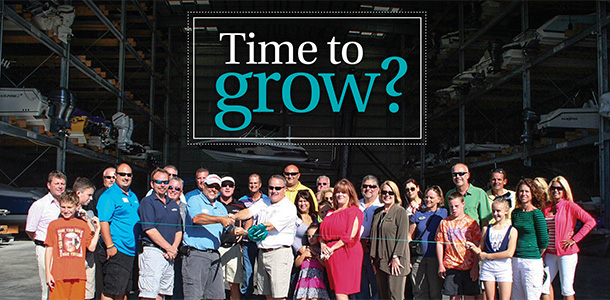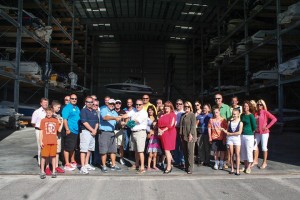Time to grow?

Multi-store survivors on growing wisely, and knowing when to say no
Marine is a mature industry in a growing economy, currently undergoing a welcome period of expansion and consolidation after the recent thinning of the herd. This is the time in the cycle when more business owners pull the trigger on long-awaited retirements, growth-minded entrepreneurs take risks to expand and dealership groups strategically add to their empires.
With breathing room between the depths of the Great Recession and the present, dealership valuations have recovered much or all of their pre-recession losses. For those considering purchasing an existing business, the market is far beyond the bottom-out, fire-sale prices of 2009-2010, yet this period of recovery is already being defined by moves to consolidate and expand.
Such times tempt business owners who have kicked around the idea of undertaking a significant expansion to an existing store, or taking a bigger leap to add a second, third or fourth location.
Expansion isn’t for everyone, though, and those with experience strongly caution fence sitters to weigh the decision with extreme caution. Are you happy with where your business currently is at? Do you have a specific goal in mind for expansion? And, quite practically, what would it be like to split your time between multiple locations?
No matter whether you decide to take a small step, dive into a growth spurt or stay put, considering your options is a healthy process. We’ve talked to a few experts who have been there for their take on knowing when it’s time to grow, and when the best move is not moving at all.
Rethink your desire
It’s a phrase more often used among children, but business owners considering major growth need to ask themselves: “Are you sure you want to do this?” If the answer is yes, the logical follow-up is: “Why?”

There are many reasons to expand, like seizing a timely opportunity, moving into a coveted geographic area or gaining access to a new product line, but owners need to examine whether they feel coaxed into expanding solely for the sake of growing — it sounds like progress. Those who have traveled down this road speak a different tune, and urge serious reflection before making an expensive move that may not be easily undone.
“In today’s world where growth and consolidation is being forced upon us as the industries are maturing, these guys know in their gut that they’ve got to grow, but they don’t always know why or what it really means until they get there,” said John Spader, president of Spader Business Management. “Then they get there and they don’t like it — how do I get out of it?”
With 25 years of advising clients in the farm, marine, RV, powersports and construction industries, Spader has been a part of many strategy sessions helping business owners decide why, when and how to take that next step. He’s also been called in to play the role of the ambulance picking up the pieces after a misguided addition.
He recommends owners answer a fundamental question about their desire before moving forward: “Do you want stability or growth?”
Kevin Code, CEO of The Boat House, has locations in Wisconsin and Florida and just opened his sixth store in Naples, Fla. After a long career in manufacturing, he purchased his first marine dealership in Cape Coral, Fla., in 2009 as the world economy approached its nadir.
While growing his group, he has employed a strategy of establishing store clusters at opposite ends of the country — north and south — while adhering to the idea that dealerships should only grow for a good reason. In his case, that means betting on historically stable boat brands and building or buying stores in locations he deeply understood to minimize risk.
“If you’re doing it to grow, to me that’s probably not the right idea,” Code said. “If there’s synergy and strategic reasons for doing it, then by all means move forward. When you add a second store you have two sets of costs, you have two sets of management tasks, you have two infrastructures and two cultures, so it isn’t as easy as adding $5 million and $5 million together … and [thinking] it’s just going to be easy.”
Honing your processes
Beyond desire, Strong’s Marine President Jeff Strong urges dealers that are sizing up to focus strongly on evaluating their people and processes. The goal isn’t just to succeed in adding a location, but to also ensure that it’s “done in an enjoyable, profitable way.”
After his most recent acquisition last spring, the pros and cons of growing are fresh on his mind. Strong has steadily expanded his family business from one location up to a four-store group with more than 50 full-time employees.
Creating process maps for all key positions, completed as part of achieving Marine Five Star Dealer Certification, has been a big step toward refining Strong Marine’s best practices, as well as creating job templates that could be transferred to new locations.

Rather than creating cookie-cutter locations that all look and feel the same, Strong said the payoff of building finely tuned process maps is ensuring a consistent employee and client experience at all of his family’s stores.
“If we have good processes in place, the likelihood is that the client experience is going to be consistent,” he said. “More likely than not, when we fall short and have an upset employee or client, it’s because either our process wasn’t clear or it wasn’t trained well.”
Spader says the diversity of changes that accompany growth can surprise employees and owners alike, and can occasionally bring unwanted changes in day-to-day duties.
“The bigger you get, the tighter your processes will need to get and the more narrow the job functions, so the more important it is to get the right person in the right now,” he said.
He added that there’s often a big shift in daily operations that happens as organizations add their third or fourth store. This shift means that, instead of handling a few duties with aplomb, all employees need to become more specialized and narrow their daily duties to match the increased volume.
“You’ve hit a point where you’ve got to significantly change the way that everything gets managed and done, from the president or general manager … all the way to the front-line people,” he said. “You hit a critical mass where there’s just a whole other way you’ve got to start doing things or it becomes chaos.”
Culture without borders
While being a newcomer in a mature industry isn’t easy, Code says his most critical challenge has been establishing a uniform corporate culture that works within the infrastructures of all six locations. Fostering such an atmosphere has been one of the most enjoyable challenges along his path.
“Culture, to me, is actually one of the fun things,” he said. “The reason I travel is I like to get to the stores, I like to be with the people. I feel very blessed with our people and I sell at the shows with them, not because they need me, mostly because I really like to do it, and it’s the one time when I get to do what they get to do year round.”
Aside from jetting between Wisconsin and Florida locations, as well as his family home in Iowa, Code takes his staff out boating whenever possible, and also uses dinners and the occasional evening cocktail as a way to get everybody in sync, share values and help develop a uniform culture regardless of location. His intent has been to create The Boat House culture without dictating to his employees.
“I don’t want a bunch of team players who are told what to do,” he said. “I want people to understand that ultimately the customer is first and for most of our customers you’re building a dream, you’re selling them something that they’ve looked forward to weeks on end, maybe weeks, sometimes years, and the more they understand from the customer’s perspective what they’re doing, the more latitude they have to accommodate the customer.”
Strong also extolls the virtues of sorting out management processes and putting the right people in vital positions, as well as creating a uniform company culture among locations.
“Every manager has their own style that adds a nuance and a little different feel to [locations], and we try to encourage that,” Strong said. “We want the processes to be the same, but in terms of a manager’s individual ability to add their personality to it, we think that’s a good thing.”

In weighing each of his company’s expansions, Strong said the discussion begins with the board, including his sons Jay and Ryan and wife, Re. Outside of the family, the company works with a family business consultant that has provided valuable advice over the years. Strong’s Marine also has a good relationship with its local bank, as well as a long-term accountant that has assisted with the company’s finances.
“The biggest thing is to reach out to other people, whoever you think those other people [are] in your world that would be able to hold the conversations in confidence, but yet that you respect in the community, and then try to be a good listener to what they say,” he said. “Sometimes you can get hell-bent on doing something … but you might not really spend as much time as you should listening to what they have to share with you.”
Nuts and bolts
In looking ahead, it’s often easier for business owners to focus on the potential upsides of additional locations, rather than the downsides. Spader said that anticipating money-saving economies of scale is one of the biggest myths with expanding one’s operation.
“Maybe you save in health insurance because now you have 200 employees instead of 50, but then you’re going to give that savings back in all the technologies to hook all the stores together,” he said. “Every industry that we’re in, when you look at the dollars of expense per employee … the bigger you get, they go up. You will save in some areas because of scale, but there are other areas you’ve got to spend it that more than offset it.”
In presenting both the pretty and ugly truths of expansion, Spader says it can be amazing to watch the transformation among owners or business managers deciding whether to expand.
During the process, Strong suggests putting significant time into creating budget scenarios that range from sunny days to worst-case scenarios. It’s crucial, he said, to consider how the company could survive if a worst-case prediction became reality.
To leave no stone unturned, Spader Business Management recommends that its clients walk into the process with their eyes wide open and consult with somebody that can examine the decision from a distance and an untethered perspective.
“You get three times as big and it’ll bite back and fail ten times as fast, because it gets so much more complex and you have to manage them so much more proactively to stay ahead of it,” Spader said. “I’ve watched so many lose everything that were running good one- or two-store business, then get big and lose it all — it will bite back so fast and so hard.”




